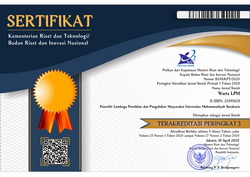Pemanfaatan Biji Lamtoro untuk Pembuatan Kecap dan Pemberdayaan Kelompok PKK di Desa Kaliploso Cluring, Banyuwangi
DOI:
https://doi.org/10.23917/warta.v26i2.1094Keywords:
lamtoro seeds, soy sauce, training, pkk group empowermentAbstract
The community service program carried out in Kaliploso Village, Cluring District, Banyuwangi Regency is a sharing of knowledge from chemical engineering lecturers and students to the community. The aim of implementing this program is to increase the creativity of the Kaliploso community by using lamtoro seeds as an alternative to soybeans as the basic ingredient for making soy sauce with the addition of special spices. The program implementation method begins with outreach, training in making soy sauce, fostering independent production, to monitoring, and evaluation. First, socialization to the community regarding the natural potential in Kaliploso village, especially on the nutritional content of lamtoro seeds, secondly, training on making lamtoro soy sauce is explained in detail regarding the composition, tools used, and the stages of the soy sauce making process, thirdly, assistance and encouragement for independent production to participants who have formed 4 groups to make lamtoro soy sauce at home, the last stage is monitoring and evaluation carried out to measure the level of success of the program for utilizing the natural potential and community empowerment through training in making lamtoro soy sauce. The impact of the program that has been carried out can ignite the community to be more productive, create products that can add economic value and promote prosperity in Kaliploso village, and the soy sauce product "Cap Roso" which is produced as a product the hallmark of Kaliploso village for more known by outsiders.
References
Astawan, Made. 2008. Khasiat Warna Warni Makanan. Jakarta : PT Gramedia Utama
Antriyandarti, E., Barokah, U., Baskara, R., Anandito, K., Rahayu, W., Ramadani, A. R., & Madina, A. P. (2023). Potensi Hasil Laut Pantai Sadeng. 26(1), 75–84.
Becker, F. G., Cleary, M., Team, R. M., Holtermann, H., The, D., Agenda, N., Science, P., Sk, S. K., Hinnebusch, R., Hinnebusch A, R., Rabinovich, I., Olmert, Y., Uld, D. Q. G. L. Q., Ri, W. K. H. U., Lq, V., Frxqwu, W. K. H., Zklfk, E., Edvhg, L. V, Wkh, R. Q., … فاطمی, ح. (2015). No 主観的健康感を中心とした在宅高齢者における 健康関連指標に関する共分散構造分析Title. Syria Studies, 7(1), 37–72.
Dilaga, S. H., Amin, M., Yanuarianto, O., Sofyan, S., & Dahlanuddin, D. (2021). Penggunaan Daun Lamtoro Sebagai Pakan Untuk Penggemukan Sapi Bali. Jurnal Gema Ngabdi, 3(1), 21–28. https://doi.org/10.29303/jgn.v3i1.133
Herdyastuti, N. (2006). ISOLASI DAN KARAKTERISASI EKSTRAK KASAR ENZIM BROMELIN DARI BATANG NANAS (Ananas comusus L.merr). Berkala Penelitian Hayati, 12(1), 75–77. https://doi.org/10.23869/bphjbr.12.1.200613
Karangrejo, D., Jember, K., Winarso, S., Anggriawan, R., Mutmainnah, L., & Setiawati, T. C. (2023). Peningkatan Pengetahuan Petani melalui Pelatihan Pembuatan Pupuk Organik Cair di. 26(1).
Magalhães-Guedes, K. T., Rodrigues, A. K., Gervasio, I. M., Gervasio, I., Peraro do Nascimento, A., & Schwan, R. F. (2013). Ethanol production from deproteinized cheese whey fermentations by co-cultures of Kluyveromyces marxianus and Saccharomyces cerevisiae. African Journal of Microbiology Research, 7(13), 1121–1127. https://doi.org/10.5897/ajmr12.1974
Prihtanti, T. M. (2022). Evaluasi Respon Kelompok Tani dalam Kegiatan Introduksi Budidaya Gandum. Warta LPM, 25(1), 21–32. https://doi.org/10.23917/warta.v25i1.594
Rohmah, N., Susanti, Y., Variyana, Y., Kurniawan, L. H., Nasution, M., & Bayramadhan, A. (2021). Sosialisasi Pengelolaan Limbah Rumah Tangga Secara Mandiri Untuk Efektifitas Pengolahannya. SELAPARANG Jurnal Pengabdian Masyarakat Berkemajuan, 4(3), 728. https://doi.org/10.31764/jpmb.v4i3.5187
Rosida, D. F., R, Y., & W, A. (2014). Isolasi Protein Biji Lamtoro Gung (Leucaena leucocephala) Menggunakan Cairan Rumen Domba. Jurnal Rekapangan, 8(1), 117–127.
Rosida DF, Surdayanti, N. S. (2017). Aktivitas antioksidan dan karakteristik fisikokimia effervescent lamtoro gung (Leucaena leucocephala). Jurnal Rekapangan, 11(1), 43–49.
Sayudi, S., Herawati, N., Ali, D. A., Pertanian, J. T., Pertanian, F., & Riau, U. (2015). Potencial of Leucaena Seed and Soybean As Raw Material for Making Complementation Tempeh. Universitas Riau Jom Faperta, 2(1).
Srikandi, S., Sugiarti, L., & Hardanto, S. (2017). Pemanfaatan Limbah Kecap Kedelai Dalam Pembuatan Nata De Soya. Jurnal Sains Natural, 1(2), 179. https://doi.org/10.31938/jsn.v1i2.27
Widayat, W., & Satriadi, H. (2017). Pemanfaatan Ampas Tahu Sebagai Bahan Baku Pembuatan Kecap Dengan Kapang Aspergillus oryzae. In Reaktor (Vol. 9, Issue 2, p. 94). https://doi.org/10.14710/reaktor.9.2.94-99
Widyastuti, E. S., Radiati, L. E., Thohari, I., Sawitri, M. E., & Awwaly, K. U. Al. (2011). Kajian Suhu Dan pH Hidrolisis Enzimatik Dengan Papain Amobil Terhadap pH, Total Gula Dan Warna Kecap Cakar Ayam. J. Ternak Tropika, 12(1), 63–71.
Downloads
Submitted
Accepted
Published
How to Cite
Issue
Section
License
Copyright (c) 2023 Warta LPM

This work is licensed under a Creative Commons Attribution 4.0 International License.















